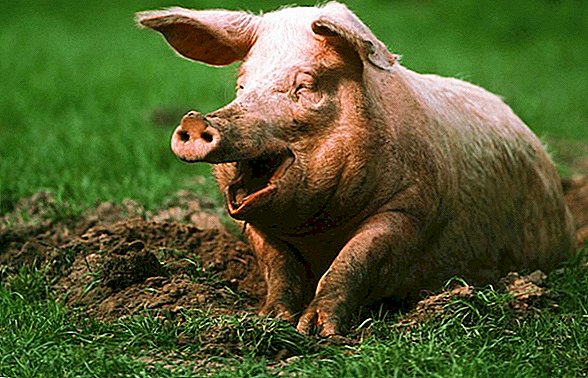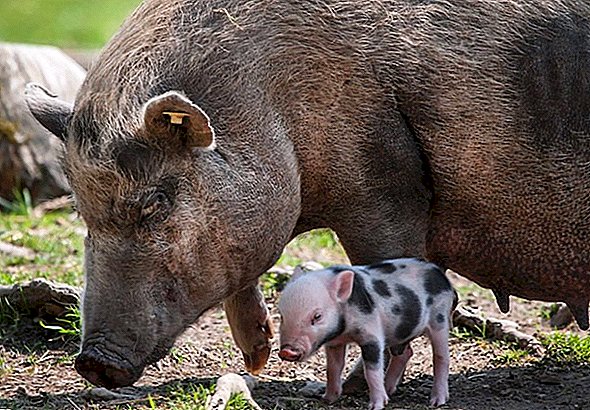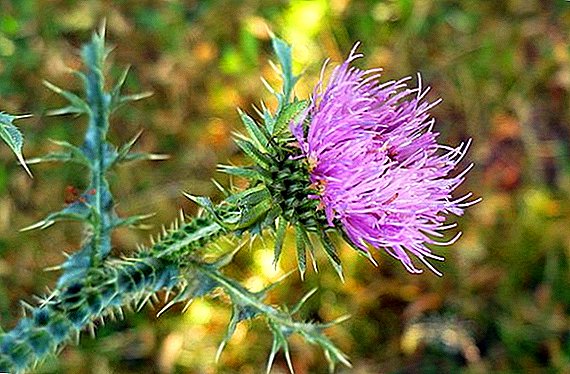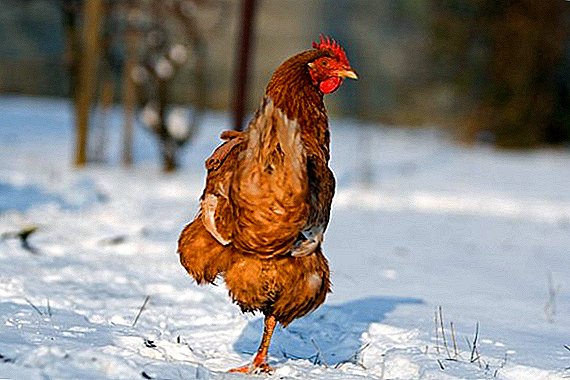 When growing livestock, it is often necessary to deal with the fact that he is ill. Therefore, it is necessary to have information on how to provide first aid to animals, in what cases it is necessary to call the veterinarian, what physiological indicators are the norm for cattle farmed. In this article, you will learn what the pig's body temperature should be and what to do when it rises.
When growing livestock, it is often necessary to deal with the fact that he is ill. Therefore, it is necessary to have information on how to provide first aid to animals, in what cases it is necessary to call the veterinarian, what physiological indicators are the norm for cattle farmed. In this article, you will learn what the pig's body temperature should be and what to do when it rises.
What temperature is considered normal
As for humans, for pigs there are norms for body temperature. An increase or decrease in this indicator indicates the development of the disease in an animal. Such a symptom may appear alone or be accompanied by other signs of deterioration in health - for example, lack of appetite, decreased motor activity, lethargy, depressed appearance.
The norms of body temperature depend on the age of the animal. In addition, they can vary depending on the breed and gender.
Did you know? Pig man tamed one of the first among wild animals. Archaeological finds in the Middle East indicate that pigs were raised by our ancestors 12.7-13 thousand years ago. The remains of domestic pigs were excavated in Cyprus. Scientists believe that they are over 11 thousand years old.
In adults
The normal indicator for this category is considered to be + 38 ... + 39 ° С. Higher rates - within 0.5 ° C - can be observed in females. Almost always, fever in females occurs during pregnancy, feeding, or sex hunting. 
Have piglets
In young animals, depending on age, there may be different indicators of body temperature. These oscillations are insignificant - in the range of 0.5-1 ° С.

Newborns
If a thermometer is put to a newborn pig, then it should normally show + 38 ... + 39 ° С. It should be noted that in the first hours after birth, depending on the microclimate in the room where the babies are kept, the temperature may drop sharply. For example, at + 15 ... + 20 ° С in a pigsty in piglets, it decreases by 1-1.6 ° С, at + 5 ... + 10 ° С - by 4-10 ° С.

Up to a year
Considered healthy are babies up to 1 year old, whose body temperature does not exceed the threshold of + 40 ° C and is not reduced below the indicator of + 38 ° C. Minor hyperthermia may occur in a hot period. If, when establishing a microclimate in a pigsty, the body temperature of the babies has returned to normal, it means that there is no need to fear for their health.
Important! Piglets are born with underdeveloped thermoregulation. This process is getting better only by the 15-20th day of life. In the first days, babies do not tolerate high humidity, combined with low temperature indicators, and therefore need dry and warm conditions.
Older than a year
For healthy young individuals that have already reached the age of one year, body temperature is characteristic from + 38 ° C to + 39 ° C.
Causes and signs of increase
The causes of heat or lowering temperature indicators in pigs can be many. Here are the main ones:
| Disease name | Body temperature, ° С | Additional symptoms |
| Erysipelas | 41-42 |
|
| Flu | 41-42 |
|
| Dysentery | 41-42 |
|
| Plague | 40,5-41 and higher |
|
| Inflammation of the respiratory organs | 41-42 |
|
| Foot and mouth disease | 40-42 and above | Afty on the coin. |
| Paratyphoid | 41-42 |
|
| Pasteurellosis | 40-41 |
|
| Ascariasis | 40-41 |
|
To suspect that the animal has a fever can be observed when observing such signs:
- cattle activity decreases;
- the pig is too excited;
- she makes frequent attempts to retire, bury herself in the litter;
- refuses to eat or eats in small portions;
- on her body there are redness, rash, swelling, boils;
- changed in color and consistency;
- diarrhea or diarrhea, vomiting;
- there was a shiver in the body;
- gait became shaky, uncertain;
- the bristles faded;
- red eyes;
- the animal is breathing heavily.
Important! An animal whose body temperature is deviated from the norm by 1.5-2 ° С and more, requires examination and treatment.
Diseases and, as a result, fever may develop for the following reasons:
- incompliance of the conditions of detention with the recommended standards;
- non-compliance with sanitary and hygienic standards;
- unbalanced diet, feeding low-quality feed, watering dirty water;
- injuries;
- infection from another animal.

Hyperthermia does not always indicate the presence of a disease in the body. It can occur, including if the animals are kept in high temperatures, stuffy. If there are no additional symptoms, it is necessary to control the temperature parameters in the pigsty and bring them back to normal. Most likely, this will lead to the fact that the body temperature in animals will also become normal.
Important! To determine the health status of pigs in terms of body temperature, deviations both upward and downward are important. Many diseases occur with a significant decrease in this indicator.
How to measure the temperature
There are several ways to find out if temperature is normal in a pig. Experienced breeders determine if the animal has fever by touching the ears, nickle and limbs with a hand. If they are hot, then most likely the fever has started.
To find out the exact figures, you need to use measuring devices. We selected a number of recommendations on how to measure the temperature of an animal with the help of various thermometers.
Mercury thermometer
The usual thermometer with a mercury scale is quite suitable not only for humans, but also for pigs. Before using it, the owner needs to position the animal to himself, as the thermometer will have to be used rectally. The piglet should be placed on the left side, its tail should be moved to the right side, stroked, scratched behind the ear and on the side, gently spoke to it and gently, slowly, as if twisting, insert the tip of the device into the anus. Pre-tip must be lubricated with petroleum jelly, vegetable oil, fat, so that it better entered the anus. The measurement time is 10 minutes. 
This method is not suitable for owners of large animals with a complex character. Therefore, there will have to look for other options, for example, the measurement of an electronic device.
Accurate indicators can only be obtained using the rectal method. Applying a thermometer to the body of an animal is not informative - the subcutaneous fat can be much cooler, since it does not transmit heat well.
Read also about popular breeds of domestic pigs.
Digital Thermometer
It is simpler to use such a device, since it shows the result much faster than a mercury thermometer - a maximum of 1 minute (the device will signal the readiness of the result with a sound signal). In addition, it is safer - if an accidental violation of the integrity of the body does not result in leakage of a hazardous substance, as is the case with a mercury thermometer. 
It is important to remember that the device must be disinfected after use. It is not allowed to use one non-disinfected thermometer for several individuals in turn.
Did you know? During the Middle Ages, courts were established that tried pigs. Animals were brought to court for breaking into homes, maiming and even killing children. For this, pigs were sentenced to imprisonment or execution.
Pyrometer
Veterinarians use more convenient and modern devices - pyrometers. They allow you to measure body temperature in a contactless way. The principle of their work is based on the action of infrared rays. Such a device is enough to bring to the pig at a distance of 5-8 cm, and the display will show the result. Data acquisition time is 1 second. The error is only ± 0.4 ° С.

What to do at elevated temperatures
If it is found that the animal has hyperthermia, it should immediately be separated from the rest of the herd. If the rates are too high and symptoms that indicate the development of a serious disease are found, it is necessary to seek veterinary advice.
If additional suspicious symptoms did not appear, then it is necessary to observe the animal for some time, placing it in the microclimate recommended for pigs. Repeated temperature measurement should be made after 1-1.5 hours.
Independently bring down the temperature is not necessary. It is necessary to establish the cause of hyperthermia and begin its treatment. You may need antibiotic therapy, which only a veterinarian should write.
Did you know? Pigs often fall in the dirt, not because they like it. Thus, they get rid of skin parasites, mosquitoes and overheating.
Tips experienced herders
To prevent the development of diseases and hyperthermia, it is necessary to listen to the following recommendations:
- It is necessary to keep newborn piglets at a temperature of + 12 ... + 15 ° С and humidity not higher than 60%.
- The content of adults should be made in conditions of + 20 ... + 22 ° C, humidity of 65-70%, good ventilation.
- Animals must be constantly monitored in order to notice and isolate the diseased individual in time.
- Once a year the animal must be examined by a veterinarian.
- Cleanliness should be maintained in the pigsty - it should be removed as needed. Disinfection must be carried out 1 time per year.
- It is important to control the quality of the feed that goes into the feeder. It should be of high quality, fresh, with no signs of mold.
- Animals should be watered with cold clean water.

So, an increase in body temperature in pigs is quite common and may indicate that the animal is sick. If the figures exceed the norm by 1-2 ° C, then this is a reason to seek immediate veterinary care. Only a specialist will determine the exact cause of hyperthermia and prescribe an effective treatment.














